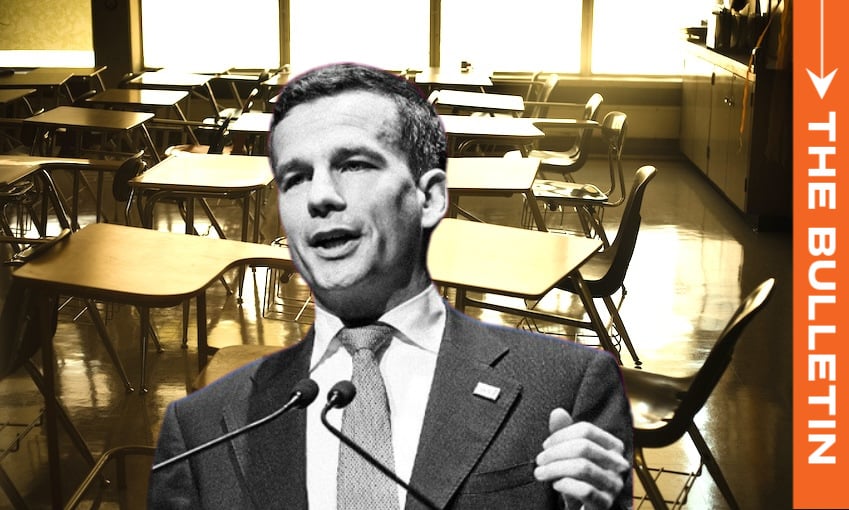|
|
|
|
|
|
|
 |
December 06, 2025
By Catherine McGregor
|
 |
|
|
|
|
|
Mōrena, and welcome to The Bulletin
In today’s edition: Top performers rise as others disappear in new ministerial rankings; Three weeks out from the budget, Willis slashes new spending plans; and just how hard are the police college tests? But first, the associate education minister has appealed for mayors' support on improving school attendance. But should it really be part of their job?
|
|
|
|
 |
Associate education minister David Seymour (Image: Getty / The Spinoff)
|
Mayors unimpressed by Seymour’s call to arms
Associate education minister David Seymour’s latest truancy push has landed awkwardly with local government leaders. In letters sent to all 78 mayors, Seymour asked them to champion school attendance in their communities, encouraging them to “lead a conversation with your community” on keeping kids in school.
As The Post’s Anna Whyte reports, a number of mayors have noted the request contradicts the government’s own messaging that councils should stick to core services like roads and water. “It’s a bit rich,” said Christchurch mayor Phil Mauger. “Nek minnit, I’ll be out cooking school lunches.” Seymour appeared unfazed, saying he was surprised mayors didn’t “put more of a smile on it” when asked to help their communities, especially given the upcoming local elections.
What the numbers actually tell us
Behind the back-and-forth is a complex picture of school attendance. The government has set a target for 80% of students to attend school more than 90% of the time by 2030. At present, just 58.1% of students meet that bar – up from 53% in 2023, but still well below pre-Covid levels.
This measure of “regular attendance” is widely used, yet controversial, as it makes no distinction between justified absences (such as illness or bereavement) and truancy. Last year Papatoetoe High principal Vaughan Couillault told The Spinoff it was a “binary” statistic that failed to reflect context. “It covers people in hospital, it covers funerals, it covers everything.” Daily all-of-school attendance rates – typically over 80% – offer a more nuanced view, but don’t feature as prominently in headlines.
|
| Is truancy really as bad as National claims? |
Action plans and accountability measures
The government has rolled out a multi-pronged strategy to address the attendance issue. A daily attendance dashboard is up and running, and the government last year launched a public awareness campaign and updated its health advice for parents. More significantly, a Stepped Attendance Response (STAR) system will be mandatory for schools from 2026, escalating interventions based on days missed.
After 15 days’ absence, prosecution of parents may be considered – though Seymour has said fines would only apply to those with the ability to pay. This prospect worries many principals, who say punitive approaches are likely to backfire. “Fining them $50 a day or whatever just takes food out of the kids’ mouths,” said Couillault. Others argue the underlying causes – poverty, health, housing – require support, not penalties. “You’ve got to get alongside [families] and understand the issues, said NZEI president Mark Potter.
The silent surge in stand-downs
Alongside concerns about absenteeism is a quieter trend: the rising number of students being formally stood down from school. Unlike suspensions, stand-downs are short-term removals – up to five days – and are often used as a circuit breaker for behavioural issues. Their use has surged since Covid, with over 30,000 stand-downs in 2023, a 35% rise since 2019. “Assuming a five-day stand-down each time, that’s 153,510 school days lost,” notes economist Cameron Bagrie, writing yesterday in BusinessDesk (paywalled).
Could the numbers be entirely due to worsening student behaviour? Bagrie isn’t so sure. “Are stand-downs still being used for the right reason, and not just the easy option? I do not know the answer – but such questions need to be asked.”
Read more from The Spinoff:
|
|
|
|
|
|
Top performers rise as others disappear in new ministerial rankings
In her latest ministerial “report card” (Premium paywalled), NZ Herald political correspondent Audrey Young has crowned Chris Bishop, Judith Collins and Chris Penk as the standout ministers of the government’s first 18 months. Bishop ("A superman in terms of workload and achievement") retains his score of nine, while Collins ("Back in control... Not a successful party leader but an excellent minister") and Penk ("Very busy, very impressive... Should be in cabinet, not outside") both jump two points to match him.
Prime minister Christopher Luxon and his deputy Winston Peters maintain a steady score of eight, while finance minister Nicola Willis drops one point to seven, reflecting mixed results on fiscal and other policy fronts.
|
|
|
|
|
|
Three weeks out, Willis slashes budget spending plans
Finance minister Nicola Willis has unveiled a far tighter budget than expected, cutting the government’s new spending allowance by $1.1 billion, reports Stuff’s Glenn McConnell. Delivering her pre-Budget speech on Tuesday at a Hutt Valley metalworks factory, Willis said the operating allowance for Budget 2025 had been cut from $2.4b – the figure as of December 2024 – to just $1.3b. While new spending will be way down, a government savings drive has freed up "billions of dollars" from existing programmes that can now be deployed elsewhere, she said.
Despite slower economic growth and mounting debt, Willis reaffirmed the government's commitment to reaching surplus by 2029. She ruled out any new taxes, including a previously signalled tax on charities, and signalled only "modest" cost of living and business support measures. With most public sector budgets frozen, she warned that this year’s Budget would not be a “lolly scramble”, with the government focusing on what Willis called New Zealand’s "most pressing priorities".
Economists spoken to by RNZ's Susan Edmunds said households "should feel limited impact" from the cutback in new expenditure, "apart from in Wellington where government spending was a significant part of economic activity".
|
|
|
|
 |
Click and Collect
|
|
|
|
 |

|
|
|
 |
Thanks for reading.
If you've enjoyed our roundup of today's news, forward The Bulletin to a friend.
|
 |
|
|
Subscribe to more
|

|
A wrap of our stories each weekday
|
|
|
|
|
|

|
The best of The Spinoff each Saturday
|
|
|
|
|
|

|
Essential reading for all things Wellington
|
|
|
|
|

|
Culture, entertainment & recommendations
|
|
|
|
|
|
|
|
|